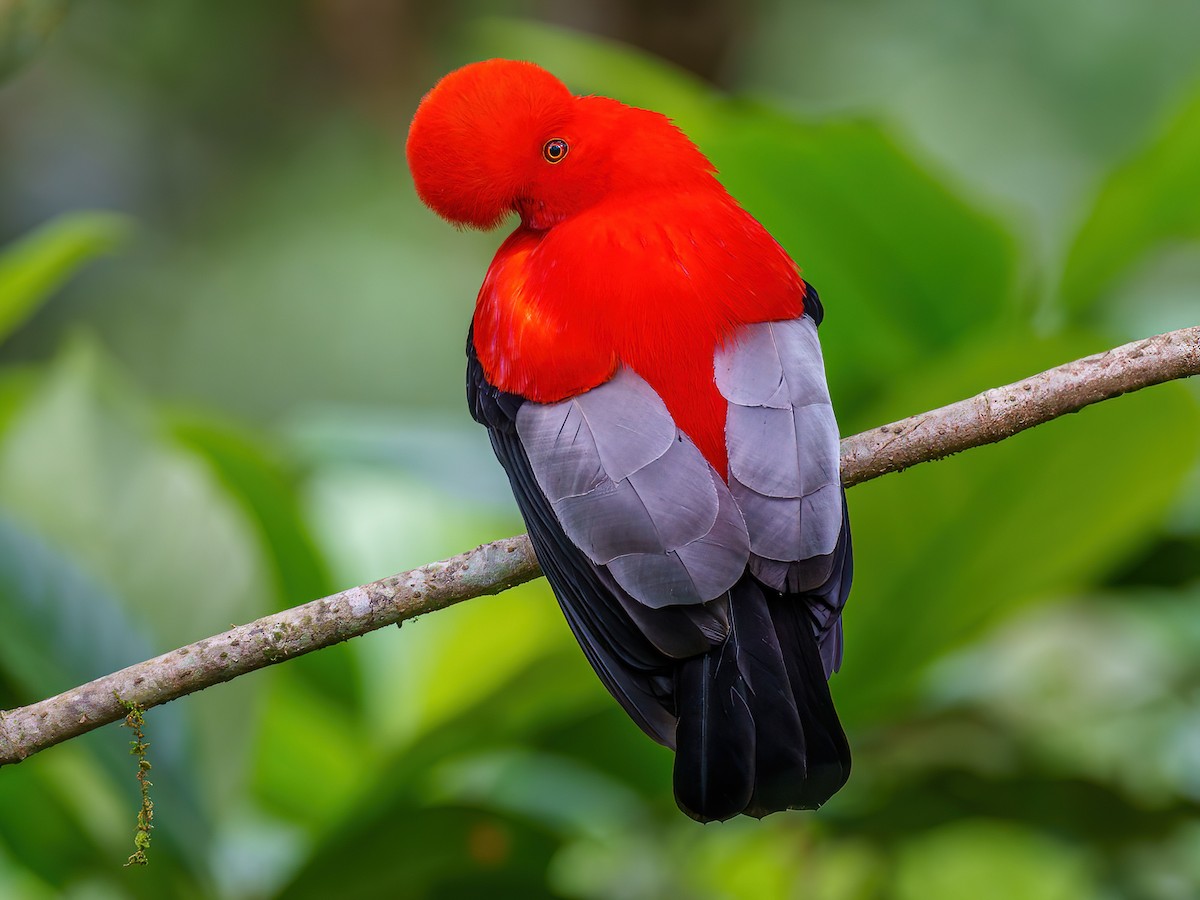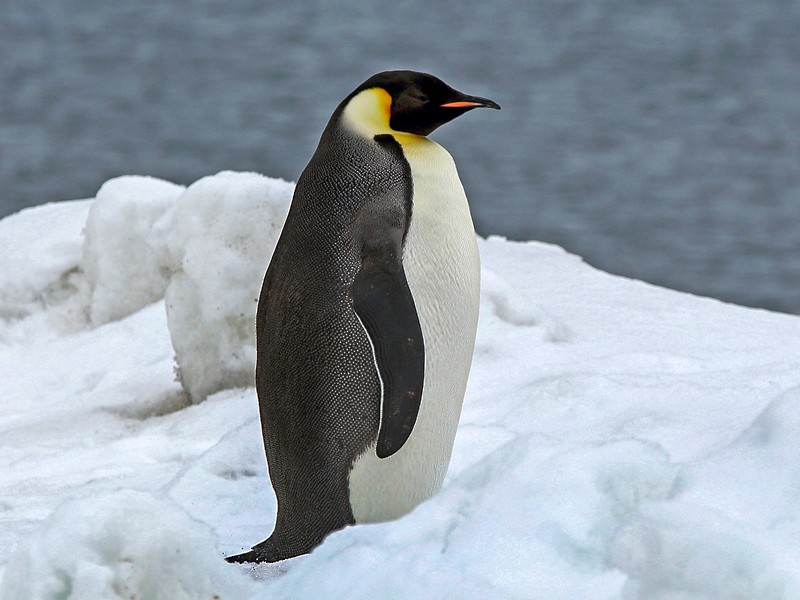Top 20 Most Beautiful Birds in the World
Imagine a world where colors brighter than a rainbow shimmer in the sunlight, where feathers gleam like jewels, and the air carries melodies straight from the wild. Birds are more than just creatures of beauty; they are nature’s vibrant marvels, each with a story of survival, adaptation, and wonder.
With plumage that rivals the finest art and flights that seem to defy gravity, these incredible beings bring a touch of magic to our world—living masterpieces waiting to be discovered.
Welcome to Stellar Eureka. Today, we embark on an exciting journey through the avian realm to uncover the 20 most beautiful birds in the world, each one a dazzling example of nature’s endless creativity.
Are you ready to explore the extraordinary lives and breathtaking beauty of these winged wonders? Let’s take flight!
20. The Splendid Fairy-Wren
Our journey begins in the enchanting landscapes of Australia, where we meet a bird so beautiful its name proudly announces its allure: the Splendid Fairy-Wren. Living up to the “splendid” in its title, this tiny marvel dazzles during the breeding season with its striking cobalt-blue plumage, as if draped in nature’s finest silks.
The male Splendid Fairy-Wren is a true showstopper of the avian world. Each spring, it transforms into a vibrant vision of blue, a display so captivating it could even outshine a peacock.
Outside breeding season, these wrens trade their dazzling feathers for more subdued brown tones, but during courtship, they step into the spotlight as nature’s supermodels, their bright hues contrasting beautifully with the wildflowers.
These lively birds bring their habitat to life with playful antics and high-energy flitting, turning the Australian wilderness into their stage. Their high-pitched calls resonate through the trees, adding a melodic soundtrack to the spectacle of their vibrant beauty, a celebration of nature’s artistry in full swing.
19. The Resplendent Quetzal
From the dazzling cobalt hues of the Splendid Fairy-Wren, we journey to the misty cloud forests of Central America, where another beautiful bird awaits: the Resplendent Quetzal. True to its name, this bird is a resplendent masterpiece, with every detail radiating beauty and wonder.
Adorned in vivid green and crimson feathers, the Resplendent Quetzal is one of nature’s most colorful creations. Its tail feathers, reaching an impressive three feet in length, cascade behind it like shimmering ribbons, giving it an ethereal elegance as it glides through the forest. When sunlight filters through the trees, its plumage sparkles with an iridescent glow, as if it’s a mythical creature come to life.
But this bird isn’t just a vision of beauty, it’s a vital part of its ecosystem. A fan of fruit, particularly avocados, the Quetzal acts as a flying gardener, spreading seeds and nurturing the forest’s growth with every flight. Its role is essential in keeping the lush landscape thriving.
Once revered as sacred by the Mayans and Aztecs, the Resplendent Quetzal now faces significant challenges. Habitat loss from deforestation and the impacts of climate change threaten its future. Protecting this extraordinary bird and its environment is not just about saving a species, it’s about preserving a symbol of the forest’s spirit and vitality.
18. The Lilac-Breasted Roller
Celebrated across African cultures as a symbol of love and loyalty, the Lilac-Breasted Roller carries profound cultural significance. Frequently featured in folklore and art, it embodies the beauty and bonds of nature, a reminder of Africa’s vibrant landscapes and rich heritage.
With its dazzling plumage blending lilac, blue, and hints of green, this bird is a true living rainbow. And really, its name, Lilac-Breasted Roller, says it all, as if nature couldn’t resist giving away the surprise. Perched on a branch or soaring through the skies, it’s a breathtaking sight that adds brilliance to the golden hues of the Savannah.
Despite the expansion of agriculture and urban development threatening the very habitats it relies on. The Lilac-Breasted Roller demonstrates remarkable resilience, thriving in parts of Africa’s vast landscapes.
This bird isn’t just a marvel to look at; it’s also an aerial acrobat. During courtship, males take to the skies, twisting and diving in spectacular displays of strength and agility, each maneuver punctuated by their loud, raspy calls, a performance as bold as their feathers.
Beyond its colorful charm, the Lilac-Breasted Roller is a resourceful predator. Perched high above, it watches intently for movement below, swooping down with precision to catch prey ranging from grasshoppers to scorpions.
17. Wilson’s bird of paradise
As you watch this feathered performer sway and hop with flair, it’s clear Wilson’s Bird of Paradise is no ordinary bird.
Its dazzling courtship display, with moves that could outshine any contestant on So You Think You Can Dance, takes center stage amidst the vibrant greens of Waigeo Island. But as mesmerizing as this performance is, it’s heartbreaking to think that such displays could one day become a rarity due mostly to its habitat destruction and illegal trapping, making every dance a precious reminder of nature’s fleeting wonders.
This incredible display doesn’t happen by chance. The male meticulously clears his stage, sweeping away stray leaves to ensure his electric-blue skin, vivid red plumage, and quirky handlebar-like tail feathers take the spotlight.
Every hop, twirl, and flutter is carefully choreographed to impress nearby females, who perch quietly, watching his every move. It’s nature’s equivalent of a Broadway production, and with a name like Wilson’s Bird of Paradise, an homage to naturalist Edward Wilson, it seems this bird was born for the limelight.
Beyond its eye-catching performance, Wilson’s Bird of Paradise plays a vital role in its ecosystem. Feeding on fruits and insects, it helps to disperse seeds, maintaining the balance of the lush tropical forest. This little dynamo is not just a performer, but a crucial part of its environment.
16. Red bearded Bee eater
From the breathtaking dances of Wilson’s Bird of Paradise, we now shift to the lush and humid forests of South Asia, where we encounter a bird as vibrant as it is cunning, the Red-Bearded Bee-Eater.
With its vivid green body and a striking scarlet throat resembling a flamboyant beard, the Red-Bearded Bee-Eater truly embodies its descriptive name. It’s as if the scientists who named it couldn’t resist highlighting both its colorful appearance and its dining habits.
But this bird isn’t just a beauty; it’s a skilled aerial hunter. Perched silently like a patient angler, it waits for the perfect moment to strike, a true ninja of the bird world, stealthy yet unmistakably stylish.
This charismatic bird adds an intriguing twist to its life by nesting in burrows dug into sandy riverbanks. It’s quite the contrast, this brilliantly colored bird disappearing into the earthy tones of its self-made home. You could almost imagine it as a feathered architect, digging a little hideaway like a bearded recluse preparing for a cozy retreat. Unlike some of its more gregarious relatives, the Red-Bearded Bee-Eater prefers a quieter life, often hunting solo or in pairs rather than flocking in groups.
15. The Harpy Eagle
Our journey through the 20 most beautiful birds in the world reaches new heights with the Harpy Eagle, a creature whose magnificence lies not only in its striking appearance but also in its incredible strength and dominance as a true titan of the skies.
With a wingspan stretching up to seven feet, nearly as wide as a king-sized bed, and talons as large and sharp as grizzly bear claws, this bird is nature’s ultimate powerhouse. It can carry prey weighing up to 20 pounds. Imagine hoisting a small dog through dense rainforest at speeds of up to 50 miles per hour. That’s the astonishing power of the Harpy Eagle.
Witnessing this majestic bird soaring through the canopy is like seeing a fighter jet glide effortlessly across the skies, its vast wings slicing through the greenery with precision and grace. Its sheer presence commands respect, a living emblem of nature’s raw power and intricate balance.
The Harpy Eagle is a master of stealth and strength, targeting monkeys, sloths, and other tree-dwelling animals that think themselves safe high above the ground. With the agility of a gymnast and the precision of a seasoned hunter, it navigates dense rainforest foliage to strike with deadly accuracy. Its hunting skills are so advanced that even creatures adept at hiding stand little chance once the Harpy Eagle sets its sights.
Yet this apex predator is more than just a hunter, it’s an ecological cornerstone. By preying on overpopulated species, the Harpy Eagle helps maintain balance within its environment, ensuring the rainforest thrives in harmony. Without this magnificent bird, the intricate web of life in the jungle could unravel.
But even the mighty Harpy Eagle faces daunting challenges. Habitat destruction from deforestation and agricultural expansion threatens its towering nests, which can weigh over 100 pounds and take years to rebuild. With only one egg laid every two to three years, their population recovery is painstakingly slow. Conservationists are working tirelessly to protect the rainforests and secure the survival of this awe-inspiring bird.
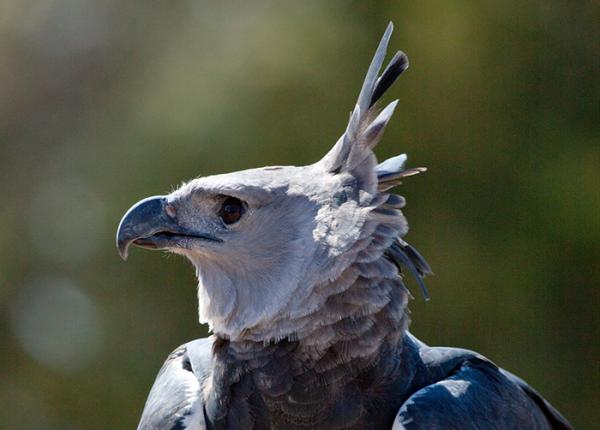
14. Secretary Birds
From the commanding skies of the Harpy Eagle, we now step onto the sun-drenched savannas of Africa to meet a bird that trades soaring flights for an elegant and purposeful march: the Secretary Bird. Nicknamed Africa’s Marching Eagle, this fascinating raptor combines the grit of a predator with the grace of a runway model, creating a spectacle that’s both captivating and unique.
Standing nearly 5 feet tall, the Secretary Bird is a striking figure. Its long, slender legs give it an almost regal stance, while its sleek grey and black feathers are crowned with quill-like plumes that evoke the elegance of an aristocrat dressed for a royal affair. But beneath this polished exterior lies a formidable hunter with one of the most distinctive hunting styles in the avian world.
Unlike most raptors that swoop from the skies, the Secretary Bird patrols the ground with its trademark strut, scanning the savanna for unsuspecting prey. When the moment comes, it unleashes powerful, bone-crushing stomps with legs that deliver blows faster than most animals can react. Its dramatic stomping even flushes prey out of hiding, turning each hunt into a theatrical performance worthy of an encore.
Beyond its flair for the dramatic, the Secretary Bird is an opportunistic diner. Its varied menu includes snakes, lizards, rodents, and even small birds. Think of it as nature’s buffet enthusiast, ready to sample whatever the savanna has to offer.
With its nickname, Africa’s Marching Eagle, and a hunting style that combines efficiency with drama, the Secretary Bird stands tall, both literally and figuratively, as one of the most beautiful and intriguing birds on Earth.
13. Keel-Billed Toucan
From Africa’s marching marvel, we now journey back to the lush rainforests of Central and South America, where an explosion of color awaits. Meet the Keel-Billed Toucan, often nicknamed the “rainbow-billed bird” for its dazzling, multicolored beak, a true showstopper of the rainforest.
With its vibrant bill painted in electric greens, fiery oranges, and vivid blues, the Keel-Billed Toucan looks like a piece of living art, as if nature itself decided to experiment with its boldest palette. This stunning bird isn’t just admired for its appearance, it’s a lively character with playful antics that mirror its colorful charm.
Keel-Billed Toucans are social creatures, thriving in flocks that fill the forest with their croaking calls, creating a symphony of life in the canopy. Their remarkable beaks aren’t just decorative; they’re highly functional, acting as built-in fruit pickers that allow the toucan to pluck juicy treats from even the most challenging branches. Beyond their love of fruit, these birds contribute significantly to their ecosystem by dispersing seeds, helping to sustain the rainforest’s biodiversity, ensuring the continued growth of the very forests they call home and supporting countless other species along the way.
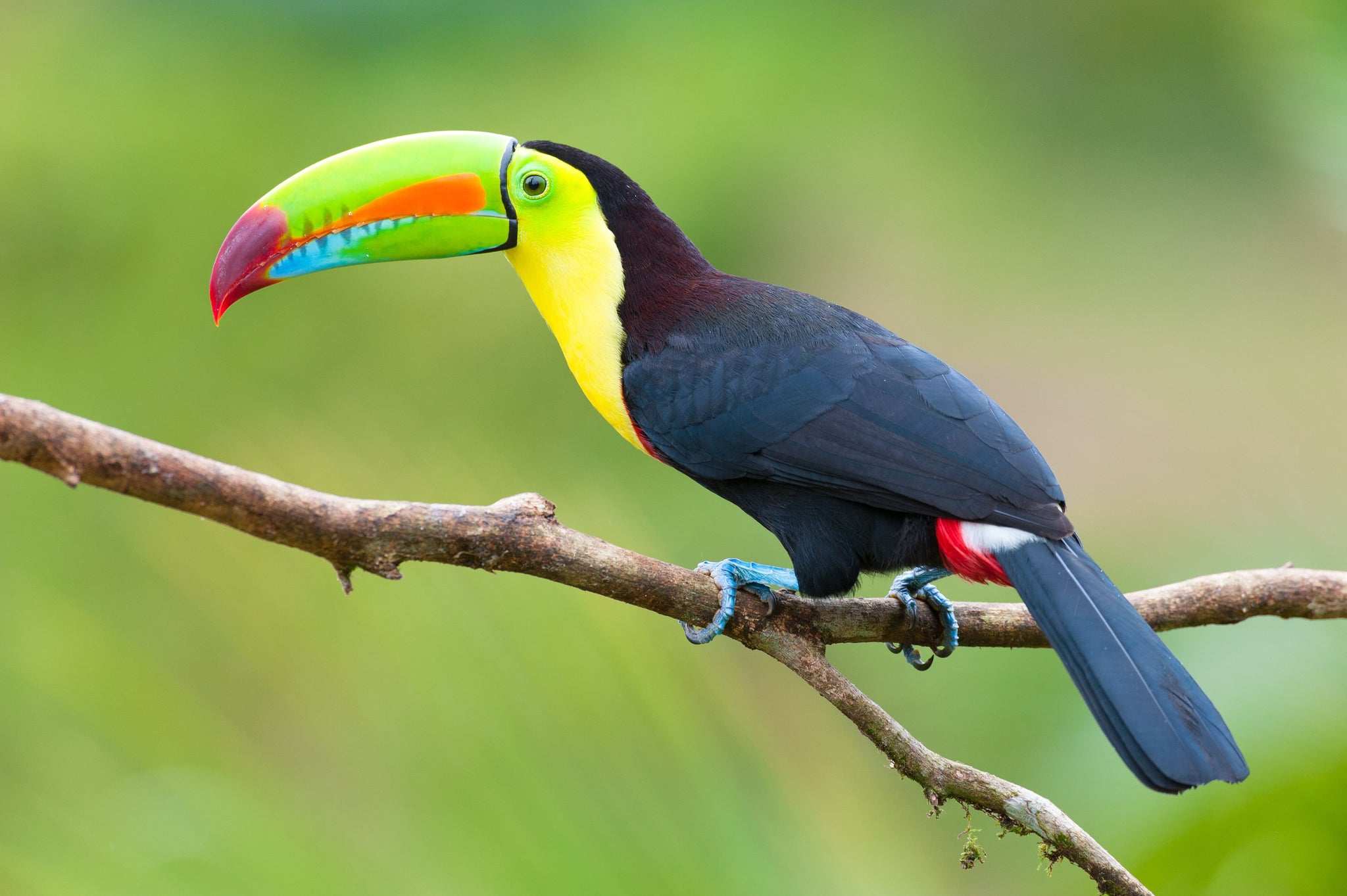
12. The Great Horned Owl
With their haunting hoots and majestic presence, Great Horned Owls are more than just nighttime predators, they’re symbols of mystery and power in the animal kingdom. Like many of the beautiful birds in this episode, these captivating creatures face growing threats from habitat loss and hunting, raising serious concerns about their future.
Away from the African rainforest, our journey now takes us into the twilight hours of North America to meet this incredible bird of prey. The Great Horned Owl commands the night with its tufted “horns” and piercing yellow eyes, an iconic look that makes it one of the most recognized owls in the world.
With a wingspan stretching up to 4.6 feet, these owls glide through the night sky in absolute silence, their feathers specially adapted to muffle sound, a skill perfectly suited for ambushing their prey.
Masters of stealth, Great Horned Owls use their keen eyesight to detect even the faintest movements in near darkness. Their menu is as varied as their hunting tactics, ranging from rabbits and squirrels to skunks and even other birds of prey. It’s nature’s ultimate buffet, and these owls are not picky eaters. After dining, they leave behind tidy pellets of fur and bones, a fascinating reminder of their ecological role.
Yet, these fierce hunters have a softer side. During courtship, males puff up their feathers and bob their heads, letting out deep, melodic calls to woo potential mates. It’s an enchanting display of charm and confidence that echoes through the stillness of the night and that perhaps you have been lucky enough to hear.
11. The Andean cock-of-the-rock
Our next marvel on this list of beautiful birds is the Andean Cock-of-the-Rock, a stunning symbol of the rainforest’s intricate and vibrant ecosystem. With its radiant orange-red plumage and striking fan-shaped crest, this bird is a living masterpiece, as though painted directly from the rainforest’s vivid palette. Found in the misty cloud forests of Ecuador and neighboring regions, it embodies both flamboyance and function in the wild.
The Andean Cock-of-the-Rock’s courtship rituals are a spectacle of nature’s drama and creativity. Males gather at leks, or communal display grounds, tucked deep within the forest. There, they perform bold and noisy displays, bobbing their heads, flapping their wings, and croaking loudly to outshine their rivals.
Perched like discerning judges, the females observe this lively competition, carefully selecting the most captivating performers. It’s as if the jungle transforms into a vibrant stage, where only the best can claim their prize.
Beyond their dramatic displays, these birds are unsung heroes of the rainforest. Like other fruit-loving birds we’ve explored in this video, the Andean Cock-of-the-Rock plays a crucial role in seed dispersal. As enthusiastic fruit eaters, they play a vital role in seed dispersal, ensuring the forest’s lush greenery continues to flourish.
While the males revel in their theatrical performances, the females balance this flamboyance with practicality. They construct sturdy nests from mud, high on rocky cliffs, ensuring safety and stability for their eggs. It’s a grounded and essential counterpart to the males’ dramatic displays, highlighting the balance of beauty and purpose that defines the Andean Cock-of-the-Rock’s remarkable life.
10. Magnificent Frigatebird
Continuing our journey through one of the most beautiful birds in the world, we are now focusing on the Galapagos Islands, home to the aptly named Magnificent Frigatebird. Once again, scientists weren’t exaggerating when they gave this bird its title, it truly is a masterpiece of nature, from its striking appearance to its fascinating behavior.
During the breeding season, these seabirds take center stage with a courtship display that’s nothing short of spectacular. Male frigatebirds inflate their vibrant red throat pouches into dazzling balloons while drumming loudly and vibrating their wings to attract a mate. It’s like nature’s own red-carpet event, where the best-dressed wins the day.
Once they’ve paired up, resourcefulness takes over, nests are built from twigs and branches, often stolen from neighbors. Sharing, as it turns out, isn’t part of the program.
With an impressive wingspan nearing eight feet, the Magnificent Frigatebird commands the skies, gliding effortlessly for days at a time. Its aerodynamic grace is unparalleled, but surprisingly, its feathers lack waterproofing. For a bird that lives so close to the ocean, this creates a curious vulnerability—a dip in the water could spell disaster.
Equally intriguing are their bold dining habits. Magnificent Frigatebirds are infamous kleptoparasites, chasing smaller seabirds like Blue-footed Boobies in midair to force them to regurgitate their meals. It’s a daring, albeit cheeky, strategy that solidifies their reputation as the sky’s ultimate opportunists.
From their aerial acrobatics and daring dining strategies to their flamboyant courtship rituals, the Magnificent Frigatebird earns its title with every remarkable trait. Whether in the air, on land, or in the realm of avian lore, this bird proves that “magnificent” is no exaggeration.
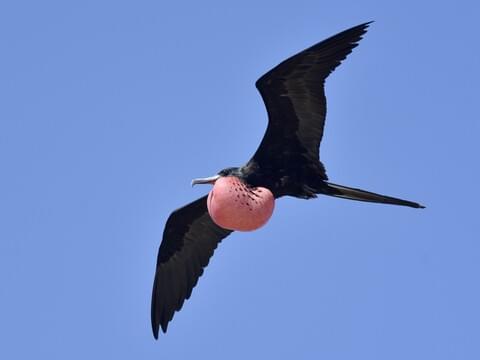
9. Curl-Crested Aracari
After marveling at the grace of the Magnificent Frigatebird, we now journey back to the vibrant rainforests of Central and South America to meet a flamboyant and playful cousin of the toucan: the Curl-Crested Aracari. With its crown of delicate curls and a multicolored bill resembling a tropical sunset, this bird is a living testament to nature’s creativity and flair.
As a charismatic member of the toucan family, the Curl-Crested Aracari captures attention with its unique crown of soft curls and its vibrant, multicolored bill, a natural masterpiece that sets it apart even in the lively rainforest canopy. This bird doesn’t just blend in; it commands the treetops with its dynamic movements and bold presence, turning every encounter into a spectacle of nature’s creativity.
But this bird isn’t just about looks; it’s a social butterfly, or rather, a social aracari. Often seen in small, chattering flocks, these birds fill the canopy with playful energy, their calls echoing like nature’s version of lively banter, a vibrant spectacle that could rival any daytime drama.
Its diet of fruits, especially berries and figs, makes the Curl-Crested Aracari an essential seed disperser. Much like other beautiful birds featured in this episode, it plays a crucial role in ensuring the next generation of plants takes root in the jungle. And that remarkable bill? Far from just being decorative, it’s a highly efficient tool, perfectly designed for expertly plucking fruit from even the trickiest branches
From its ties to the iconic toucan to its vibrant presence in the jungle, the Curl-Crested Aracari embodies the joyous spirit of the rainforest. Who wouldn’t be charmed by this feathered fashionista?

8. African Grey Parrot
From the vivid treetops of the rainforest to the captivating skies of Africa, we now spotlight a bird whose brilliance lies not only in its beauty but also in its mind, the African Grey Parrot.
Adorned in sleek grey plumage that gleams like polished silver and a striking red tail that adds a splash of vibrancy, the African Grey Parrot is a visual delight. But this bird’s appeal goes far beyond appearances. It’s celebrated as one of the most intelligent creatures in the animal kingdom, earning it the nickname of “the Einstein of birds.”
These parrots are legendary for their ability to mimic human speech with uncanny precision. Imagine a pet not only chatting with you but also throwing in the occasional witty comeback! With vocabularies that can span hundreds of words, African Grey Parrots are conversational marvels, capable of echoing phrases with a cadence and tone so accurate it’s hard to believe it’s not a person. But mimicry is just the beginning—these birds are also exceptional problem-solvers.
Studies have shown that African Greys possess cognitive abilities comparable to a four-year-old child. They can grasp abstract concepts like size, shape, and even basic arithmetic. It’s as if nature combined the best of beauty and brains into one compact, feathered package. One minute they’re solving puzzles with precision; the next, they’re dazzling you with their antics, swinging from toys or cozying up for a friendly chat.
However, this intelligence comes with its challenges. African Greys demand high levels of mental stimulation and social interaction to stay happy and healthy. Without it, they risk boredom, which can lead to destructive behaviors like feather plucking. They’re social beings at heart, thriving on connection with their flock, whether that flock is feathered or human.
Could you imagine sharing a conversation with a bird this intelligent? With African Greys, it’s not just possible, it’s unforgettable.
7. The Scarlet Macaw
From the lush canopies of Central and South America, the Scarlet Macaw emerges as both a celebration of nature’s artistry and a species facing mounting challenges. Unfortunately, habitat destruction from agriculture and logging, along with illegal trapping for the pet trade, continues to threaten these beautiful birds.
Compared to the African Grey Parrot, which we marveled at earlier for its intelligence and muted elegance, the Scarlet Macaw is its dazzling, flamboyant cousin. Trading cool, grey tones for radiant red, yellow, and blue feathers, the macaw’s bold colors are a signature of its outgoing personality. While the African Grey is celebrated for its mimicry, the Scarlet Macaw is more about making a statement, its loud, raucous calls echo across the rainforest, as colorful as its wings.
If it feels like the bird was dipped into a painter’s palette, you’re looking at a Scarlet Macaw. And while it doesn’t rival the African Grey’s conversational prowess, the Scarlet Macaw communicates through a symphony of squawks and expressive movements, bringing energy and life to the rainforest.
Beyond their beauty, Scarlet Macaws are also ecological gardeners. Feeding on fruits, nuts, and seeds, they use their powerful beaks to crack tough shells and disperse seeds throughout the forest.
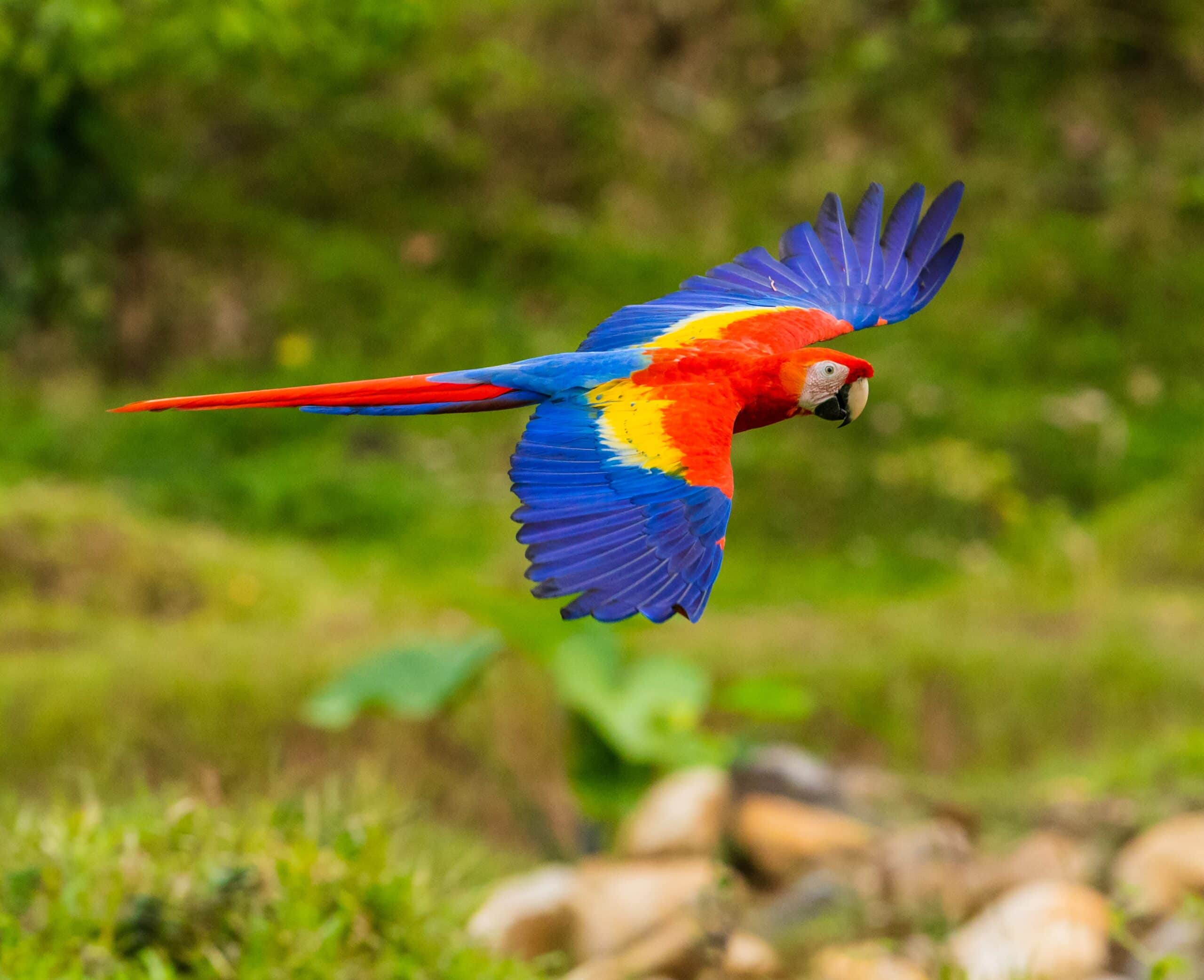
6. Flame Bowerbird
We now venture into the rainforests of southern New Guinea to meet a bird that takes creativity to dazzling new heights: the Flame Bowerbird. Not only does this bird light up the forest with its fiery plumage, but it also turns it into an art gallery with creations that would impress even the most seasoned decorators.
This beautiful bird truly lives up to its name. The male Flame Bowerbird is a vision of orange-red brilliance, with golden-yellow feathers and a black-tipped tail. It’s as though someone painted a sunset and brought it to life. But the real show begins when he starts building his avenue bower. It’s like a tiny architect designing twin walls of perfectly placed sticks, decorated with fruits, flowers, and shiny treasures. Each bower is a masterpiece, carefully crafted to catch the eye of a potential mate.
When a female arrives to inspect his work, the male takes center stage, performing an intricate dance that showcases his plumage in all its glory. He twists his tail, flutters his wings, and even plays with his gaze by altering the size of his pupils to create a hypnotic effect. Add in his raspy calls and hissing notes, and you’ve got a performance that’s part dance-off, part magic show, and entirely mesmerizing.
But while the male dazzles with his flamboyance, the female gets to work. She builds a separate, hidden nest high in the trees to lay her eggs, ensuring the next generation of Flame Bowerbirds thrives. It’s a perfect balance of artistry and practicality that keeps this species thriving in its rainforest home.
With its radiant colors, architectural genius, and spectacular displays, the Flame Bowerbird is more than just a beautiful bird, it’s nature’s ultimate showman
5. Blue Jay
After marveling at the artistic flair of the Bowerbird, we return to North America to meet a bold and mischievous character: the Blue Jay.
With its vibrant blue plumage and striking black markings, this bird brings an undeniable energy to backyards and woodlands alike. The Blue Jay isn’t just a feast for the eyes, it’s a true character, often stealing the spotlight with its raucous calls that echo through the trees. And it doesn’t stop there, these clever birds have a knack for mimicking hawks to send other feathered friends into a frenzy. Who knew such beauty could come with a bit of drama?
Famed for their resourcefulness, Blue Jays thrive on a diverse diet ranging from seeds and acorns to insects, and yes, sometimes even other birds’ nestlings. Their love for acorns earns them a role as nature’s accidental foresters, as the nuts they bury and forget often sprout into new oak trees. Watching one crack open an acorn with its strong beak is a reminder of just how perfectly adapted they are to their environment.
When it comes to family life, Blue Jays are no slouches. These birds form lifelong pairs and share the responsibilities of building their large, twiggy nests. Males prove to be excellent partners, often bringing food to their mates while they incubate eggs. It’s a charming display of teamwork and loyalty, proving that lovebirds aren’t the only romantic species out there.
Although they face challenges like habitat loss and predation by cats, Blue Jays have proven themselves highly adaptable to human-altered environments. Whether raiding bird feeders or sneaking snacks left out for pets, these crafty birds have mastered the art of coexisting with humans. Their bold personalities and intelligence ensure they’re always a captivating sight, and their role in the ecosystem as seed spreaders makes them invaluable.
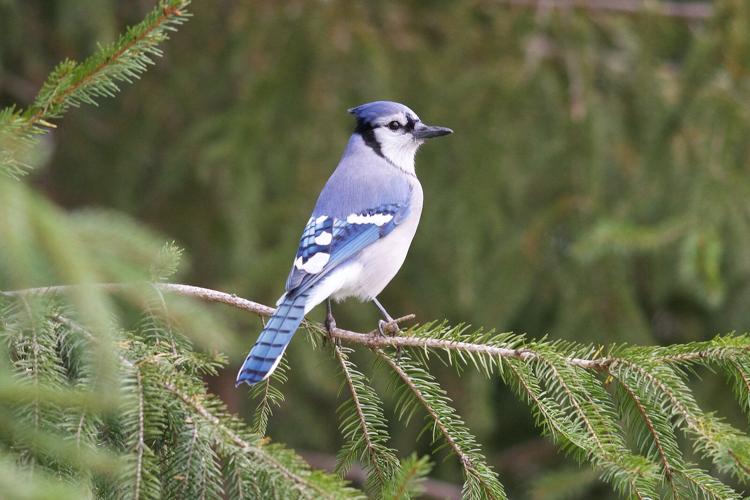
4. The Golden Pheasant
After marveling at the bold personality of the Blue Jay, we now journey to the vibrant forests of central China, home to one of nature’s most dazzling displays: the Golden Pheasant.
This beautiful bird is a living masterpiece, boasting plumage that seems to radiate sunlight. With its brilliant gold and crimson feathers and fiery red crest, the male Golden Pheasant looks as though it’s been dipped in the hues of a royal tapestry, ready to steal the show at any forest gathering.
Despite their breathtaking beauty, these birds aren’t just about appearances. Golden Pheasants are avid foragers, often seen scratching through the forest floor in search of seeds, fruits, and insects.
Of course, no Golden Pheasant segment would be complete without mentioning their spectacular courtship displays. When it comes to wooing a mate, the males don’t hold back, they puff out their feathers, fan their golden capes, and perform intricate dances that rival even the most extravagant peacocks. It’s a display of confidence and flair that leaves onlookers in awe.
3. Crowned Crane
We return to Africa to meet a bird that combines charisma with breathtaking elegance: the Crowned Crane. This avian gem is a symbol of the African wetlands, gliding gracefully through its lush habitat and captivating all with its striking appearance.
With a crown of golden feathers atop its head, the Crowned Crane seems to wear nature’s own tiara, a perfect complement to its elegant grey and white plumage. But this bird isn’t just about looks, it’s also an accomplished performer.
Its courtship dances are nothing short of mesmerizing, with synchronized movements, bobbing heads, and flapping wings creating a graceful ballet against the vibrant African backdrop. These displays aren’t just for attracting mates; they strengthen bonds within flocks, showcasing the crane’s deeply social nature.
But life for the Crowned Crane is far from just a performance. As omnivorous foragers, these cranes have developed a clever technique to uncover hidden prey. By stamping their feet, they flush out insects, small fish, and amphibians from their hiding spots, demonstrating a resourcefulness that ensures their survival in diverse environments. Often seen in pairs or small groups, they share their findings while staying ever watchful for predators, a testament to their resilience and teamwork.
2. The Snowy Owl
We find ourselves now in the silent beauty of the Arctic, where the Snowy Owl reigns as a true symbol of this icy wilderness. This ethereal and beautiful bird glides across the tundra with a grace that matches its ghostly white plumage, embodying the majesty of the northern landscape.
Life in the Arctic demands resilience, and the Snowy Owl is perfectly equipped for the challenge. With thick, insulating feathers acting as nature’s version of a down jacket, this owl braves sub-zero temperatures with ease. Its striking yellow eyes and white plumage, pure in males and stylishly barred in females, make it one of the most visually stunning birds of the avian world. These adaptations are not just about surviving but thriving in one of Earth’s harshest habitats.
Unlike most owls, the Snowy Owl is diurnal, hunting during the endless daylight of Arctic summers. Perched on low mounds or rocks, it scans the frozen expanse with sharp eyes and keen hearing, ever ready to pounce on its favourite prey: lemmings. These nimble hunters swoop down with the precision of a ballet dancer, talons poised to catch their unsuspecting meal. Their diet is so intertwined with lemming populations that a single Snowy Owl family can consume over 1,600 lemmings in a year.
Yet, the Snowy Owl’s story isn’t just one of predation. These majestic birds also display remarkable devotion as parents. Nesting directly on the ground, females lay 4 to 8 eggs, taking charge of incubation while the males diligently provide food. The result? Fluffy chicks that resemble tiny snowballs, ready to wobble their way into the world under the watchful eyes of their doting parents.
However, life on the tundra is becoming increasingly precarious. With rising temperatures and fluctuating lemming populations, Snowy Owls face challenges that unfortunately threaten their survival.

1. The Emperor Penguin
As we conclude our list of the 20 most beautiful birds in the world, we journey to the icy expanse of Antarctica to meet the regal Emperor Penguin, the final marvel in our avian adventure. These majestic birds are not only the largest penguin species but also Antarctic royalty, thriving against all odds in one of Earth’s harshest climates.
Standing nearly 45 inches tall, the Emperor Penguin is a striking vision, with its iconic black and white plumage accented by golden-yellow hues on its neck and head. It’s a bird that commands admiration not just for its elegance, but also for its remarkable resilience. In temperatures as low as -58°F and winds up to 124 mph, these penguins endure an environment that tests the limits of survival. Their dense, double-layered feathers, around 70 per square inch, and substantial fat reserves are nature’s answer to a perfect winter coat, shielding them from the brutal cold.
Equally awe-inspiring is their cooperative strategy for surviving the harsh Antarctic winters. In huddles of up to 5,000, these penguins take turns at the center of the group, sharing warmth and ensuring no individual is exposed to the relentless cold for too long. It’s a remarkable display of unity, where survival is truly a collective effort.
The Emperor Penguin’s dedication extends to its extraordinary breeding cycle. In the depths of winter, females lay a single egg, entrusting it to the males for incubation. These devoted fathers balance the egg on their feet under a protective brood pouch, fasting for 65 days and often losing nearly half their body weight in the process. Meanwhile, the females embark on a journey to the sea to feed, returning just in time for the chicks to hatch.
When the fluffy young emerge, they depend on both parents for warmth and food. Parents alternate foraging trips, bringing back sustenance to help their chicks grow strong enough to venture out on their own. Yet, life remains precarious. The scarcity of sea ice can lead to food shortages, posing a significant threat to the survival of the chicks.
Despite their incredible adaptations, Emperor Penguins face increasing challenges from climate change and the rapid loss of sea ice. These icy landscapes are crucial to their survival, and their decline threatens not only the penguins but also the delicate Antarctic ecosystem they inhabit. Safeguarding these iconic birds is essential, not just for their survival but for the preservation of one of the planet’s most unique environments.
Conclusion
From the majestic to the extraordinary, these 20 beautiful birds remind us of nature’s boundless creativity and beauty, each one a living masterpiece with its own unique tale. Which one stole your heart? Let us know your favorite in the comments below.
As you continue to marvel at the wonders of the bird world, remember that there’s always more to discover. Whether soaring high above the treetops or navigating the icy expanses, these incredible creatures showcase the diversity and resilience of life on Earth.
